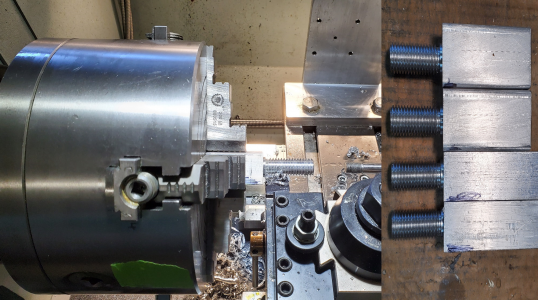I would recommend doing things a bit differently, and I thread up to 600+ RPM. First thing to understand is it is not about what you set the braking speed too, the VFD can only deaccelerate at a maximum speed and using anything under 1 second will most likely result in less repeatability and possibly an overvoltage fault with a larger chuck/mass that will put you into a free run mode with no braking. If a VFD is setup to prevent an overvoltage event because the braking rate is too fast, it will modulate the braking which changes the stopping position. Second is that the VFD braking rate is based on your maximum Hz setting, so if it is set to 100 Hz and 1 second, it will brake at 0.5 seconds at 50 Hz and 0.25 seconds at 25 Hz. Third you do not predict where the VFD/cutter will stop, as this can vary greatly based on the spindle RPM, mass, Hz, etc. It is not something that I calculate.
First you need to determine the stopping position that you want, put the cutter to the end of thread position, if using the cross slide than this is where the cutter stops in a perpendicular plane to the long axis, if using the compound then it is the position with the compound advanced to the final cutting depth where you want it to end in the relief groove. Zero your DRO or dial gauge to this position. Turn you speed dial to about 25-30% of maximum speed and select a gearing range that gives you your target RPM. So if your maximum Hz is 100, and you want to thread at 200 RPM, select 800 RPM maximum and turn the speed pot down to 25% (this is with 1 second braking). With the threader off or away from the work, engage the half nut and do some trial runs, until your stop position is at the "0.000" stopping point. with the cutter just touching the starting diameter zero the cross slide dial and if using the compound zero that dial. Do a scratch pass to verify everything and begin you threading runs. The stopping distance should repeat within 0.001".
I gave up a long time ago using the compound, and just use the cross slide for thread cutting, the main reason is the stopping position of the cutter tip does not change as opposed to the compound. I use the thread cutter to cut my relief, I add about 0.01" to my target depth. I get clean cuts no matter what the material, steel I thread in the 300 RPM range for 1" diameter stock, aluminum 600+ RPM. I have threaded down to 11 TPI, below that point a compound may be a better option. I just complete some 1"-14 threading in 1144 and 4140 to an external depth of 0.098" and an internal of 0.106", I start out at 0.02" 1st pass, then 0.01" advance per pass, at around 0.08" start reducing the incremental DOC, and one spring pass when done.
Example below was for multiple pieces that all needed to be indexed (started/stopped) at the same point relative to the square stock so they all thread to the same position when screwed in. This required indexing the part and accurate start/stopping position, the half-nut was not disengaged for all four pieces, pitch was 5/8"-11. Chuck and parts were marked, I used a rod in the tailstock to set the stick out of the square stock to start the thread at the same point. This was done using the cross slide to advance the threading tool, probably 600 RPM.



